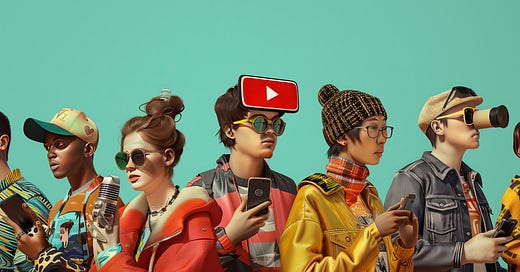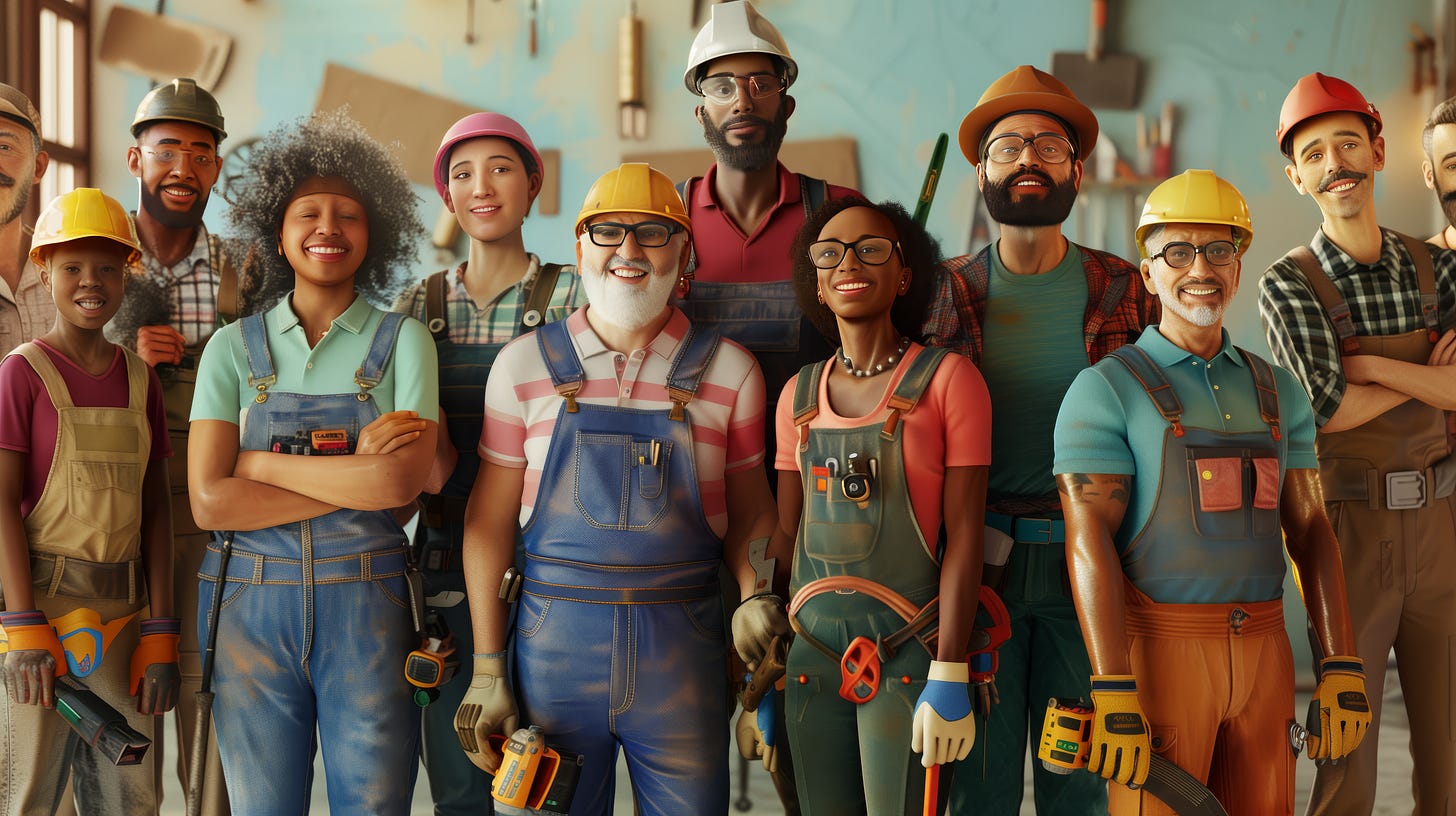YouTube vs. Hollywood: How Amateurs Reshaped the Media Industry
Hello all! Jeff here, and welcome to the launch of my Substack blog, where every week I’ll be investigating a different aspect of the history of storytelling in the media: from how the Kodak company predicted social media in a single ad campaign, to how YouTube and AI are changing the entertainment industry today. I’ve been a professional in the traditional TV game for over twenty years, and a lover of film and television – not to mention home movies – my entire life. Glad you're here!
And so without further ado. My first post:
YouTube vs. Hollywood: How Amateurs Reshaped the Media Industry
The Revolution Begins
Picture this: What if plumbing became so accessible that anyone could become a plumber overnight? Imagine a flood of amateur plumbers armed with basic tools competing with seasoned professionals.
Or consider amateur flag football rivaling the NFL in popularity, with a charismatic player named “Mr. Beast” becoming the highest-paid athlete globally.
These scenarios might seem far-fetched, but they serve as apt analogies for what has happened to the entertainment industry with the rise of YouTube.
The Early 2000s: Before YouTube
To appreciate YouTube's impact, we must first recall the media landscape before it.
When I started in the entertainment industry in the late 1990s, it was a specialized field, difficult to break into. Television networks, radio stations, and print media were the primary sources of content. Major film studios and music labels held significant power, controlling what reached mass audiences. To break into the industry, you literally had to know somebody, and then work your butt off 80 hours a week for little pay, and THEN get lucky.
Like many recent film school grads, I’d been inspired by the new wave of indie filmmakers that brought fresh voices to art house cinema screens, and seemed to redefine what was possible in the movies. I envisioned myself crafting thought-provoking one-of-a-kind art, following in the footsteps of Richard Linklater, Tarantino, The Coen Brothers, and Wes Anderson.
But for every Kevin Smith who maxed out their credit cards to make a film and became a breakout success…there were thousands of others who were just stuck with the debt, and a half-decent film that couldn’t get distribution.
For aspiring content creators (note: not a term yet back then), the barriers to entry were formidable. Producing and distributing content required substantial financial resources, specialized equipment, and industry connections. This exclusivity fostered a certain level of quality and artistry—or at least that's what we told ourselves.
But then came YouTube, a platform that revolutionized content creation and media consumption, making it possible for anyone to become a "filmmaker." In doing so, it fundamentally altered what we consider compelling content.
The YouTube Revolution
In February 2005, Chad Hurley, Steve Chen, and Jawed Karim launched YouTube, a video-sharing website that changed the face of media. YouTube lowered the barrier to entry for creators, making it possible for anyone with a camera and an internet connection to share their content with the world. This shift was revolutionary—and for some, deeply unsettling.
Initially, YouTube was populated with a hodgepodge of amateur videos: home movies, pet antics, and low-budget music videos. The platform's first viral hit, "Me at the zoo," was a mere 18-second clip of co-founder Jawed Karim at the San Diego Zoo. But as users became more familiar with the platform, content began to diversify. Aspiring comedians found an audience with sketch comedy videos, while tech enthusiasts shared product reviews and unboxing videos. The "vlog" or video blog emerged as a popular format, allowing individuals to share their daily lives and thoughts directly with viewers.
As YouTube matured, so did its content. The platform began to attract more polished creators who saw the potential for building a career on YouTube. Makeup tutorials, cooking shows, and educational content flourished. YouTube became a launchpad for musicians, with Justin Bieber famously being discovered through his YouTube videos. The gaming community found a home on the platform, with "Let's Play" videos and live streams drawing massive audiences. Meanwhile, YouTube's partnership program, introduced in 2007, allowed creators to monetize their content, further professionalizing the platform and attracting talent from traditional media.
The platform's growth has been nothing short of phenomenal. As of 2024, YouTube boasts over 2.5 billion monthly active users, with 500 hours of video uploaded every minute. This explosive growth has fundamentally altered the media landscape. Very few people dream of being a famous writer-director anymore. Everyone – including my 6 year old son – dreams of being a YouTuber.
"YouTube has created a new breed of celebrity who engages directly with their audience." - Susan Wojcicki, former CEO of YouTube
Suddenly, individuals who might never have had access to traditional media channels could produce and distribute their work to a global audience. The sanctity of film school education and hard-won industry connections is no more.
From Scorsese to Scrolling
YouTube catalyzed a significant shift in media consumption habits. The platform pioneered an on-demand model, later adopted by streaming services like Netflix and Hulu. This marked the end of appointment viewing as audiences preferred to watch content on their schedules.
More than changing when we watch, YouTube changed what we watch. The idea of compelling content underwent a radical transformation. Millions now sit glued to their screens watching people prank each other, unbox Peppa Pig toys, or go about their daily lives.
For instance, I recently noticed my wife staring at her phone, transfixed, as she watched someone cut someone else's lawn on YouTube for 15 minutes —it had 1.7 million views. To put that in perspective, this is not far off the average primetime TV show in 2023, which drew about 3 million viewers. Or the total number of people who watched Wes Anderson’s latest film, Asteroid City, in the theater: around 3.2 million.
Again, it was a guy cutting someone else’s lawn. Yes, the lawn was a mess, but…still. This shift is both fascinating and, for those of us who once dreamed of creating meaningful cinematic art, somewhat disheartening.
The New Celebrities
YouTube has given rise to a new form of celebrity. Influencers, ranging from beauty gurus to political commentators, have built massive followings and wield significant cultural influence. Take MrBeast, who has become one of the highest-paid content creators in the world. His elaborate stunts and giveaways have earned him millions of subscribers and billions of views – and recently a $100 million deal with Amazon to do a game show. $100 million!!
The Reluctance of Traditional Filmmakers to Hop on the Bandwagon
Like many other professionals in the "real" entertainment industry, I never got into YouTubing, even as it crept into legitimacy. It wasn't for me—I went to film school, for goodness' sake. The idea of filming quick, off-the-cuff videos seemed worlds apart from the meticulous, thoughtful approach I learned and cherished. Many of my peers felt the same, clinging to the belief that true filmmaking required more than just a camera and an internet connection.
However, this reluctance created a divide between traditional and new media creators. It’s also led to the current panic among traditional media companies – who failed to recognize the real threat that YouTube and its social media siblings posed. It’s finally realized that – oh crap, these idiots taping themselves playing video games and doing crazy stunts are coming for our jobs.
Conclusion: Navigating the New Normal
I’m not saying that high-end content traditional media has the power to produce is going away. But it’s clear that the democratization of content creation is here to stay, and it will continue to get even easier for anyone, anywhere to make a compelling film and release it to the world. As AI filmmaking technology continues to improve and become more available, some kid in Iowa with no connections, but a passion and a Midjourney subscription could, hypothetically, win an Oscar someday. I really believe this. And my hope is that perhaps it could lead to another new wave of compelling original indie films being made at crazy low budgets.
And, in case you are wondering, yes, I did just finally start a YouTube channel of my own with my family, and have begun frantically learning AI tech so I too can maybe make that art house darling I always dreamed of. Who knows.
What do you think? Has YouTube improved or diminished the art of filmmaking? How do you see the future of content creation evolving? Share your thoughts and experiences in the comments below.
---
About the Author:
Jeff Cvitkovic is a filmmaker with over 20 years of experience in the entertainment industry. He recently went back to school to get his Master’s in Writing at Johns Hopkins University. He has helped produce, write, direct and edit shows and films for nearly every major network. And he just started a kid’s You Tube channel: http://www.youtube.com/@MsMysteryandFriends
Don’t forget to like and subscribe!!







